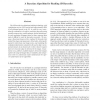Free Online Productivity Tools
i2Speak
i2Symbol
i2OCR
iTex2Img
iWeb2Print
iWeb2Shot
i2Type
iPdf2Split
iPdf2Merge
i2Bopomofo
i2Arabic
i2Style
i2Image
i2PDF
iLatex2Rtf
Sci2ools
CRV
2009
IEEE
2009
IEEE
A Bayesian Algorithm for Reading 1D Barcodes
The 1D barcode is a ubiquitous labeling technology, with symbologies such as UPC used to label approximately 99% of all packaged goods in the US. It would be very convenient for consumers to be able to read these barcodes using portable cameras (e.g. mobile phones), but the limited quality and resolution of images taken by these cameras often make it difficult to read the barcodes accurately. We propose a Bayesian framework for reading 1D barcodes that models the shape and appearance of barcodes, allowing for geometric distortions and image noise, and exploiting the redundant information contained in the parity digit. An important feature of our framework is that it doesn’t require that every barcode edge be detected in the image. Experiments on a publicly available dataset of barcode images explore the range of images that are readable, and comparisons with two commercial readers demonstrate the superior performance of our algorithm.
| Added | 20 May 2010 |
| Updated | 20 May 2010 |
| Type | Conference |
| Year | 2009 |
| Where | CRV |
| Authors | Ender Tekin, James Coughlan |
Comments (0)

